Leadership in Business: Analysis of Leadership Styles and Development
VerifiedAdded on 2020/04/21
|9
|2157
|351
Essay
AI Summary
This essay provides a critical analysis of two key leadership styles: autocratic and democratic. It delves into the characteristics, advantages, and disadvantages of each style, connecting them to relevant leadership theories such as transactional and transformational leadership. The essay uses real-world examples, citing Ray Kroc of McDonald's as an example of autocratic leadership and Jeff Bezos of Amazon as an example of democratic leadership, to illustrate how these styles are applied in practice. Furthermore, it includes a leadership development plan, outlining personal strengths and weaknesses, setting goals, and defining objectives to enhance individual leadership qualities. The essay concludes by highlighting the importance of understanding and applying various leadership styles for effective business management and organizational success.
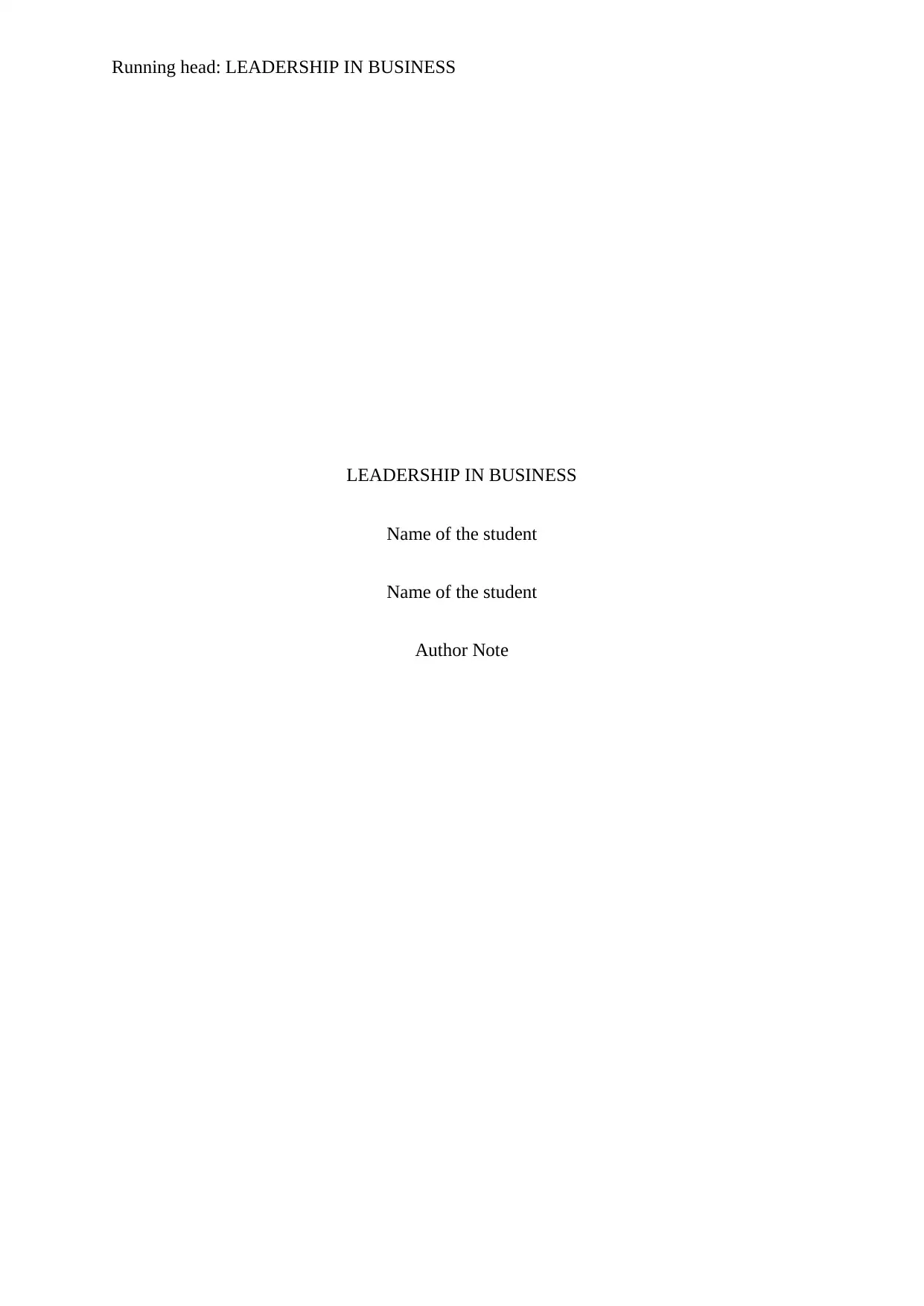
Running head: LEADERSHIP IN BUSINESS
LEADERSHIP IN BUSINESS
Name of the student
Name of the student
Author Note
LEADERSHIP IN BUSINESS
Name of the student
Name of the student
Author Note
Paraphrase This Document
Need a fresh take? Get an instant paraphrase of this document with our AI Paraphraser
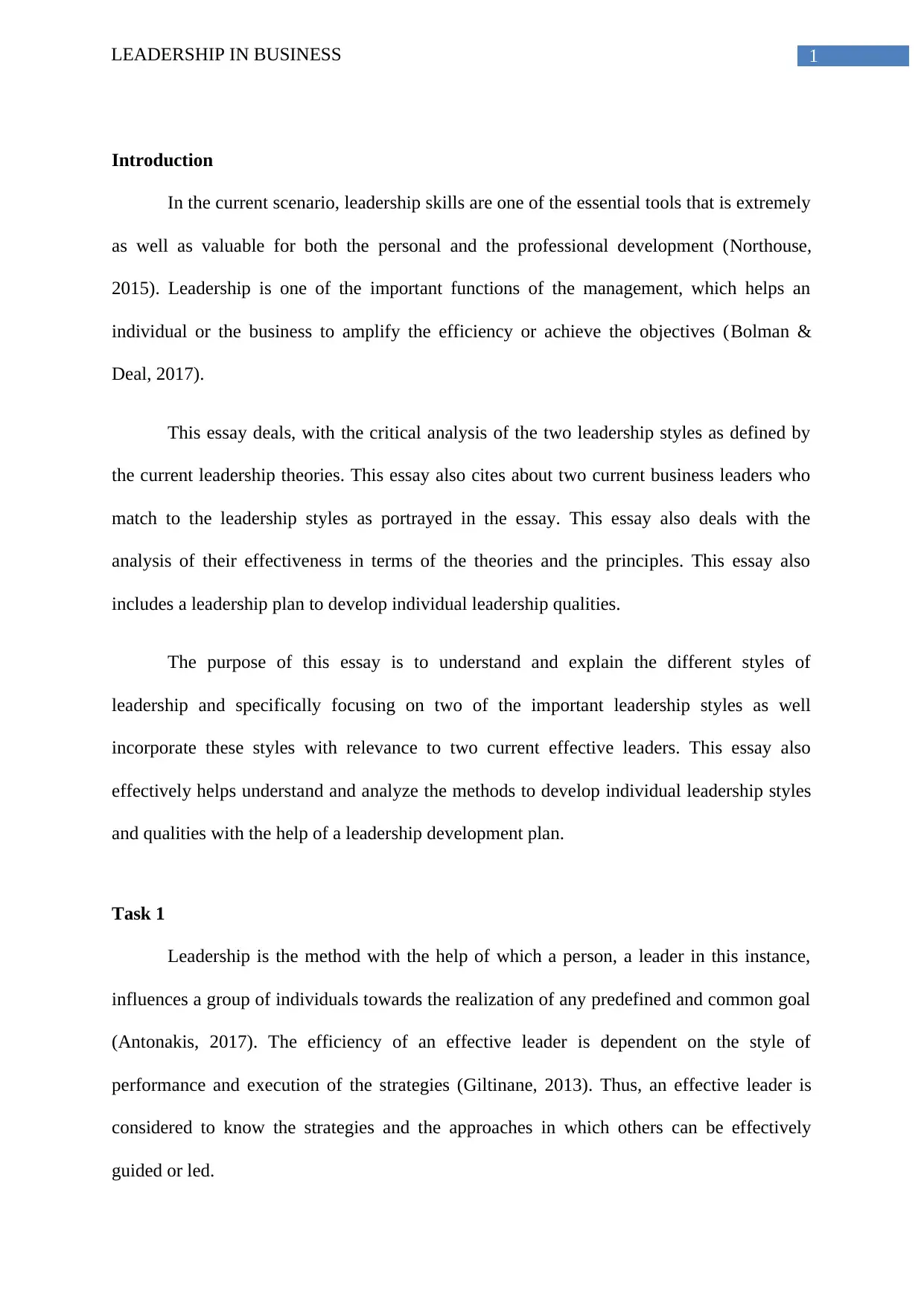
1LEADERSHIP IN BUSINESS
Introduction
In the current scenario, leadership skills are one of the essential tools that is extremely
as well as valuable for both the personal and the professional development (Northouse,
2015). Leadership is one of the important functions of the management, which helps an
individual or the business to amplify the efficiency or achieve the objectives (Bolman &
Deal, 2017).
This essay deals, with the critical analysis of the two leadership styles as defined by
the current leadership theories. This essay also cites about two current business leaders who
match to the leadership styles as portrayed in the essay. This essay also deals with the
analysis of their effectiveness in terms of the theories and the principles. This essay also
includes a leadership plan to develop individual leadership qualities.
The purpose of this essay is to understand and explain the different styles of
leadership and specifically focusing on two of the important leadership styles as well
incorporate these styles with relevance to two current effective leaders. This essay also
effectively helps understand and analyze the methods to develop individual leadership styles
and qualities with the help of a leadership development plan.
Task 1
Leadership is the method with the help of which a person, a leader in this instance,
influences a group of individuals towards the realization of any predefined and common goal
(Antonakis, 2017). The efficiency of an effective leader is dependent on the style of
performance and execution of the strategies (Giltinane, 2013). Thus, an effective leader is
considered to know the strategies and the approaches in which others can be effectively
guided or led.
Introduction
In the current scenario, leadership skills are one of the essential tools that is extremely
as well as valuable for both the personal and the professional development (Northouse,
2015). Leadership is one of the important functions of the management, which helps an
individual or the business to amplify the efficiency or achieve the objectives (Bolman &
Deal, 2017).
This essay deals, with the critical analysis of the two leadership styles as defined by
the current leadership theories. This essay also cites about two current business leaders who
match to the leadership styles as portrayed in the essay. This essay also deals with the
analysis of their effectiveness in terms of the theories and the principles. This essay also
includes a leadership plan to develop individual leadership qualities.
The purpose of this essay is to understand and explain the different styles of
leadership and specifically focusing on two of the important leadership styles as well
incorporate these styles with relevance to two current effective leaders. This essay also
effectively helps understand and analyze the methods to develop individual leadership styles
and qualities with the help of a leadership development plan.
Task 1
Leadership is the method with the help of which a person, a leader in this instance,
influences a group of individuals towards the realization of any predefined and common goal
(Antonakis, 2017). The efficiency of an effective leader is dependent on the style of
performance and execution of the strategies (Giltinane, 2013). Thus, an effective leader is
considered to know the strategies and the approaches in which others can be effectively
guided or led.
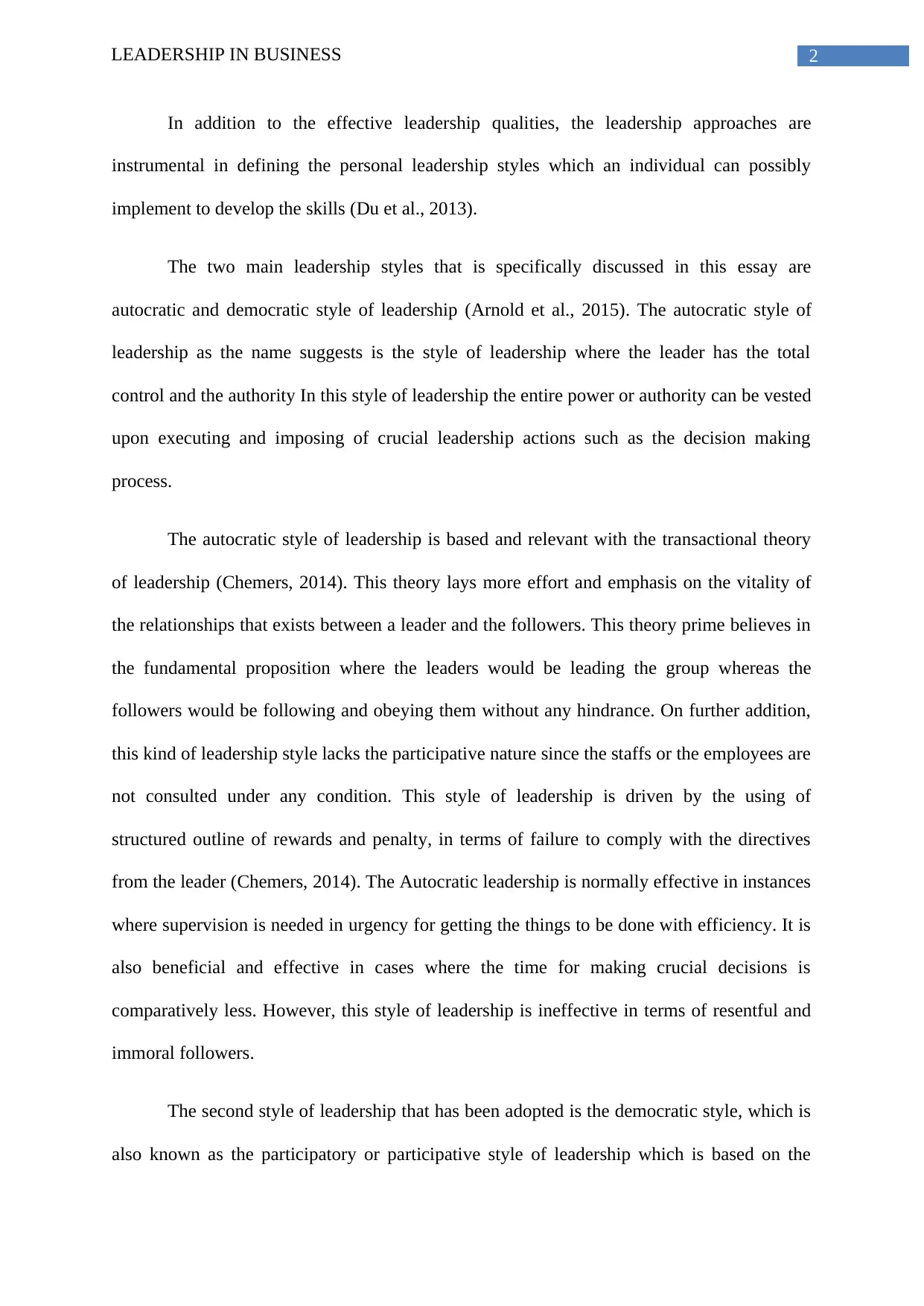
2LEADERSHIP IN BUSINESS
In addition to the effective leadership qualities, the leadership approaches are
instrumental in defining the personal leadership styles which an individual can possibly
implement to develop the skills (Du et al., 2013).
The two main leadership styles that is specifically discussed in this essay are
autocratic and democratic style of leadership (Arnold et al., 2015). The autocratic style of
leadership as the name suggests is the style of leadership where the leader has the total
control and the authority In this style of leadership the entire power or authority can be vested
upon executing and imposing of crucial leadership actions such as the decision making
process.
The autocratic style of leadership is based and relevant with the transactional theory
of leadership (Chemers, 2014). This theory lays more effort and emphasis on the vitality of
the relationships that exists between a leader and the followers. This theory prime believes in
the fundamental proposition where the leaders would be leading the group whereas the
followers would be following and obeying them without any hindrance. On further addition,
this kind of leadership style lacks the participative nature since the staffs or the employees are
not consulted under any condition. This style of leadership is driven by the using of
structured outline of rewards and penalty, in terms of failure to comply with the directives
from the leader (Chemers, 2014). The Autocratic leadership is normally effective in instances
where supervision is needed in urgency for getting the things to be done with efficiency. It is
also beneficial and effective in cases where the time for making crucial decisions is
comparatively less. However, this style of leadership is ineffective in terms of resentful and
immoral followers.
The second style of leadership that has been adopted is the democratic style, which is
also known as the participatory or participative style of leadership which is based on the
In addition to the effective leadership qualities, the leadership approaches are
instrumental in defining the personal leadership styles which an individual can possibly
implement to develop the skills (Du et al., 2013).
The two main leadership styles that is specifically discussed in this essay are
autocratic and democratic style of leadership (Arnold et al., 2015). The autocratic style of
leadership as the name suggests is the style of leadership where the leader has the total
control and the authority In this style of leadership the entire power or authority can be vested
upon executing and imposing of crucial leadership actions such as the decision making
process.
The autocratic style of leadership is based and relevant with the transactional theory
of leadership (Chemers, 2014). This theory lays more effort and emphasis on the vitality of
the relationships that exists between a leader and the followers. This theory prime believes in
the fundamental proposition where the leaders would be leading the group whereas the
followers would be following and obeying them without any hindrance. On further addition,
this kind of leadership style lacks the participative nature since the staffs or the employees are
not consulted under any condition. This style of leadership is driven by the using of
structured outline of rewards and penalty, in terms of failure to comply with the directives
from the leader (Chemers, 2014). The Autocratic leadership is normally effective in instances
where supervision is needed in urgency for getting the things to be done with efficiency. It is
also beneficial and effective in cases where the time for making crucial decisions is
comparatively less. However, this style of leadership is ineffective in terms of resentful and
immoral followers.
The second style of leadership that has been adopted is the democratic style, which is
also known as the participatory or participative style of leadership which is based on the
⊘ This is a preview!⊘
Do you want full access?
Subscribe today to unlock all pages.

Trusted by 1+ million students worldwide
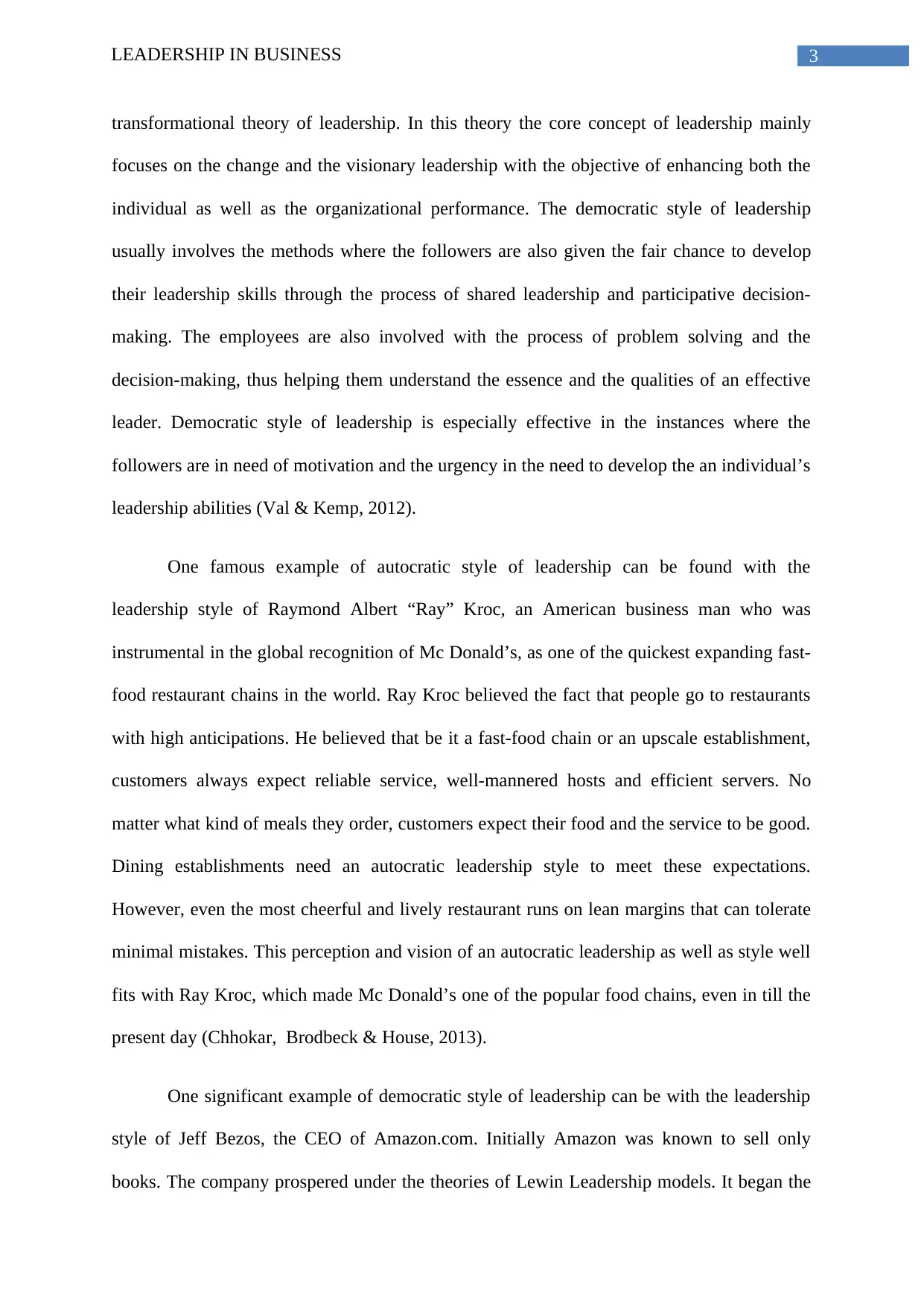
3LEADERSHIP IN BUSINESS
transformational theory of leadership. In this theory the core concept of leadership mainly
focuses on the change and the visionary leadership with the objective of enhancing both the
individual as well as the organizational performance. The democratic style of leadership
usually involves the methods where the followers are also given the fair chance to develop
their leadership skills through the process of shared leadership and participative decision-
making. The employees are also involved with the process of problem solving and the
decision-making, thus helping them understand the essence and the qualities of an effective
leader. Democratic style of leadership is especially effective in the instances where the
followers are in need of motivation and the urgency in the need to develop the an individual’s
leadership abilities (Val & Kemp, 2012).
One famous example of autocratic style of leadership can be found with the
leadership style of Raymond Albert “Ray” Kroc, an American business man who was
instrumental in the global recognition of Mc Donald’s, as one of the quickest expanding fast-
food restaurant chains in the world. Ray Kroc believed the fact that people go to restaurants
with high anticipations. He believed that be it a fast-food chain or an upscale establishment,
customers always expect reliable service, well-mannered hosts and efficient servers. No
matter what kind of meals they order, customers expect their food and the service to be good.
Dining establishments need an autocratic leadership style to meet these expectations.
However, even the most cheerful and lively restaurant runs on lean margins that can tolerate
minimal mistakes. This perception and vision of an autocratic leadership as well as style well
fits with Ray Kroc, which made Mc Donald’s one of the popular food chains, even in till the
present day (Chhokar, Brodbeck & House, 2013).
One significant example of democratic style of leadership can be with the leadership
style of Jeff Bezos, the CEO of Amazon.com. Initially Amazon was known to sell only
books. The company prospered under the theories of Lewin Leadership models. It began the
transformational theory of leadership. In this theory the core concept of leadership mainly
focuses on the change and the visionary leadership with the objective of enhancing both the
individual as well as the organizational performance. The democratic style of leadership
usually involves the methods where the followers are also given the fair chance to develop
their leadership skills through the process of shared leadership and participative decision-
making. The employees are also involved with the process of problem solving and the
decision-making, thus helping them understand the essence and the qualities of an effective
leader. Democratic style of leadership is especially effective in the instances where the
followers are in need of motivation and the urgency in the need to develop the an individual’s
leadership abilities (Val & Kemp, 2012).
One famous example of autocratic style of leadership can be found with the
leadership style of Raymond Albert “Ray” Kroc, an American business man who was
instrumental in the global recognition of Mc Donald’s, as one of the quickest expanding fast-
food restaurant chains in the world. Ray Kroc believed the fact that people go to restaurants
with high anticipations. He believed that be it a fast-food chain or an upscale establishment,
customers always expect reliable service, well-mannered hosts and efficient servers. No
matter what kind of meals they order, customers expect their food and the service to be good.
Dining establishments need an autocratic leadership style to meet these expectations.
However, even the most cheerful and lively restaurant runs on lean margins that can tolerate
minimal mistakes. This perception and vision of an autocratic leadership as well as style well
fits with Ray Kroc, which made Mc Donald’s one of the popular food chains, even in till the
present day (Chhokar, Brodbeck & House, 2013).
One significant example of democratic style of leadership can be with the leadership
style of Jeff Bezos, the CEO of Amazon.com. Initially Amazon was known to sell only
books. The company prospered under the theories of Lewin Leadership models. It began the
Paraphrase This Document
Need a fresh take? Get an instant paraphrase of this document with our AI Paraphraser

4LEADERSHIP IN BUSINESS
implementation of the Laissez-Faire theory with Jeff Bezos as the final arbitrator of all the
prime and crucial decisions, recruited many highly professional programmers, and implied
the democratic or participatory style of leadership. In the current situation, Amazon sells
almost anything and everything. Since Amazon is an online retail shopping portal sometimes
the situations demands the autocratic style of leadership due to the commitment to its
customers and service, however the company has retained and maintained its democratic
values amongst the employees, executives, division heads and the project directors (Bhatti et
al., 2012).
Task 2
Exhibit A
An efficient leader should plan for the personal as well as professional growth. This
section devises a leadership development plan to highlight on the strengths, weakness
including the personal goals and objectives for the future reference.
a. Stage 1 – Personal analysis
An effective leader should be able to draw his/her strengths to lead the subordinates in
a better way. The first key strength is Organization, which would be helpful to manage the
daily activities as well as manage the chaos to help the subordinates to work under
determination and help them structure their goals as well. The other strengths that can be
included are being responsible, articulated, structured, task oriented, determined, confident,
and visionary and effectively management of resources. Combining these skills can
effectively help assemble followers to embark on a journey to help the organization achieve
its goals.
implementation of the Laissez-Faire theory with Jeff Bezos as the final arbitrator of all the
prime and crucial decisions, recruited many highly professional programmers, and implied
the democratic or participatory style of leadership. In the current situation, Amazon sells
almost anything and everything. Since Amazon is an online retail shopping portal sometimes
the situations demands the autocratic style of leadership due to the commitment to its
customers and service, however the company has retained and maintained its democratic
values amongst the employees, executives, division heads and the project directors (Bhatti et
al., 2012).
Task 2
Exhibit A
An efficient leader should plan for the personal as well as professional growth. This
section devises a leadership development plan to highlight on the strengths, weakness
including the personal goals and objectives for the future reference.
a. Stage 1 – Personal analysis
An effective leader should be able to draw his/her strengths to lead the subordinates in
a better way. The first key strength is Organization, which would be helpful to manage the
daily activities as well as manage the chaos to help the subordinates to work under
determination and help them structure their goals as well. The other strengths that can be
included are being responsible, articulated, structured, task oriented, determined, confident,
and visionary and effectively management of resources. Combining these skills can
effectively help assemble followers to embark on a journey to help the organization achieve
its goals.

5LEADERSHIP IN BUSINESS
The areas, which can be subjected to change or improvement, are considerably the
possible weaknesses. The acknowledgement and improving of these weaknesses can be
helpful in the subjugating of crisis. The areas, which possibly need improvement, are
expansion of the administrative skills, laying emphasis on the interpersonal skills, improving
self-confidence. The other areas of improvements are communication skills, interpersonal
skills, confidently handling of relationships and technical competence. Mitigation and
improvements in the cited areas can help a leader to strengthen his unique propositions (Rast
III, Hogg & Giessner, 2013).
b. Stage 2 - Setting personal Goals
With the identification of the strengths and the weaknesses, the primary goal that can
be set for oneself is the improvement of the strengths and the weakness. Apart from this te
other five goals that can be stated are improving of the communications skills, improving of
the interpersonal skills, improving of the technical knowledge as well as competence,
improving of the confidence, focusing more on the relationships. These goals are primarily
set based on the weaknesses that needs to be improved (Gonos & Gallo, 2013).
c. Stage 3 – Personal objectives
There are certain leadership skills that need to be established from within to ensure
the efficiency of a leader. Based on this certain skills needs to be cultivated, helps understand
the significance and the values of being a good leader. With reference to the personal
objectives, certain skills can are to be implemented. The implementation of these skills are
supposedly the personal objectives, which includes the managing the team, leading the team
towards a definite goal or success. Improving the self analyzed strengths and weaknesses,
managing people and relationships as well as help the team gather and understand its full
potential to perform under pressure. Understanding and incorporating these skills, which are
The areas, which can be subjected to change or improvement, are considerably the
possible weaknesses. The acknowledgement and improving of these weaknesses can be
helpful in the subjugating of crisis. The areas, which possibly need improvement, are
expansion of the administrative skills, laying emphasis on the interpersonal skills, improving
self-confidence. The other areas of improvements are communication skills, interpersonal
skills, confidently handling of relationships and technical competence. Mitigation and
improvements in the cited areas can help a leader to strengthen his unique propositions (Rast
III, Hogg & Giessner, 2013).
b. Stage 2 - Setting personal Goals
With the identification of the strengths and the weaknesses, the primary goal that can
be set for oneself is the improvement of the strengths and the weakness. Apart from this te
other five goals that can be stated are improving of the communications skills, improving of
the interpersonal skills, improving of the technical knowledge as well as competence,
improving of the confidence, focusing more on the relationships. These goals are primarily
set based on the weaknesses that needs to be improved (Gonos & Gallo, 2013).
c. Stage 3 – Personal objectives
There are certain leadership skills that need to be established from within to ensure
the efficiency of a leader. Based on this certain skills needs to be cultivated, helps understand
the significance and the values of being a good leader. With reference to the personal
objectives, certain skills can are to be implemented. The implementation of these skills are
supposedly the personal objectives, which includes the managing the team, leading the team
towards a definite goal or success. Improving the self analyzed strengths and weaknesses,
managing people and relationships as well as help the team gather and understand its full
potential to perform under pressure. Understanding and incorporating these skills, which are
⊘ This is a preview!⊘
Do you want full access?
Subscribe today to unlock all pages.

Trusted by 1+ million students worldwide

6LEADERSHIP IN BUSINESS
perceived as the personal objectives can in turn help the organization achieve its own
objectives on personal terms (Gonos & Gallo, 2013).
Conclusion
With the help of this essay, it can be concluded that all the theories of leadership style
has certain relevance to the actual practice and the implementation of the leadership styles in
business. With the help of this essay, the two relationship styles proved that they are different
from each other in practice, however they have similar objectives that are considered for the
implementation of the same. The autocratic and the democratic style of leadership are
different in theories yet, they both are crucial in the governance of the organization as well as
managing the internal sectors of the organization.
perceived as the personal objectives can in turn help the organization achieve its own
objectives on personal terms (Gonos & Gallo, 2013).
Conclusion
With the help of this essay, it can be concluded that all the theories of leadership style
has certain relevance to the actual practice and the implementation of the leadership styles in
business. With the help of this essay, the two relationship styles proved that they are different
from each other in practice, however they have similar objectives that are considered for the
implementation of the same. The autocratic and the democratic style of leadership are
different in theories yet, they both are crucial in the governance of the organization as well as
managing the internal sectors of the organization.
Paraphrase This Document
Need a fresh take? Get an instant paraphrase of this document with our AI Paraphraser

7LEADERSHIP IN BUSINESS
References
Antonakis, J. (2017). The nature of leadership. Sage publications.
Arnold, K. A., Connelly, C. E., Walsh, M. M., & Martin Ginis, K. A. (2015). Leadership
styles, emotion regulation, and burnout. Journal of Occupational Health
Psychology, 20(4), 481.
Bhatti, N., Maitlo, G. M., Shaikh, N., Hashmi, M. A., & Shaikh, F. M. (2012). The impact of
autocratic and democratic leadership style on job satisfaction. International Business
Research, 5(2), 192.
Bolman, L. G., & Deal, T. E. (2017). Reframing organizations: Artistry, choice, and
leadership. John Wiley & Sons.
Chemers, M. (2014). An integrative theory of leadership. Psychology Press.
Chhokar, J. S., Brodbeck, F. C., & House, R. J. (Eds.). (2013). Culture and leadership across
the world: The GLOBE book of in-depth studies of 25 societies. Routledge.
Du, S., Swaen, V., Lindgreen, A., & Sen, S. (2013). The roles of leadership styles in
corporate social responsibility. Journal of business ethics, 114(1), 155-169.
Giltinane, C. L. (2013). Leadership styles and theories. Nursing Standard (through
2013), 27(41), 35.
Gonos, J., & Gallo, P. (2013). Model for leadership style evaluation. Management: journal of
contemporary management issues, 18(2), 157-168.
Northouse, P. G. (2015). Leadership: Theory and practice. Sage publications.
References
Antonakis, J. (2017). The nature of leadership. Sage publications.
Arnold, K. A., Connelly, C. E., Walsh, M. M., & Martin Ginis, K. A. (2015). Leadership
styles, emotion regulation, and burnout. Journal of Occupational Health
Psychology, 20(4), 481.
Bhatti, N., Maitlo, G. M., Shaikh, N., Hashmi, M. A., & Shaikh, F. M. (2012). The impact of
autocratic and democratic leadership style on job satisfaction. International Business
Research, 5(2), 192.
Bolman, L. G., & Deal, T. E. (2017). Reframing organizations: Artistry, choice, and
leadership. John Wiley & Sons.
Chemers, M. (2014). An integrative theory of leadership. Psychology Press.
Chhokar, J. S., Brodbeck, F. C., & House, R. J. (Eds.). (2013). Culture and leadership across
the world: The GLOBE book of in-depth studies of 25 societies. Routledge.
Du, S., Swaen, V., Lindgreen, A., & Sen, S. (2013). The roles of leadership styles in
corporate social responsibility. Journal of business ethics, 114(1), 155-169.
Giltinane, C. L. (2013). Leadership styles and theories. Nursing Standard (through
2013), 27(41), 35.
Gonos, J., & Gallo, P. (2013). Model for leadership style evaluation. Management: journal of
contemporary management issues, 18(2), 157-168.
Northouse, P. G. (2015). Leadership: Theory and practice. Sage publications.
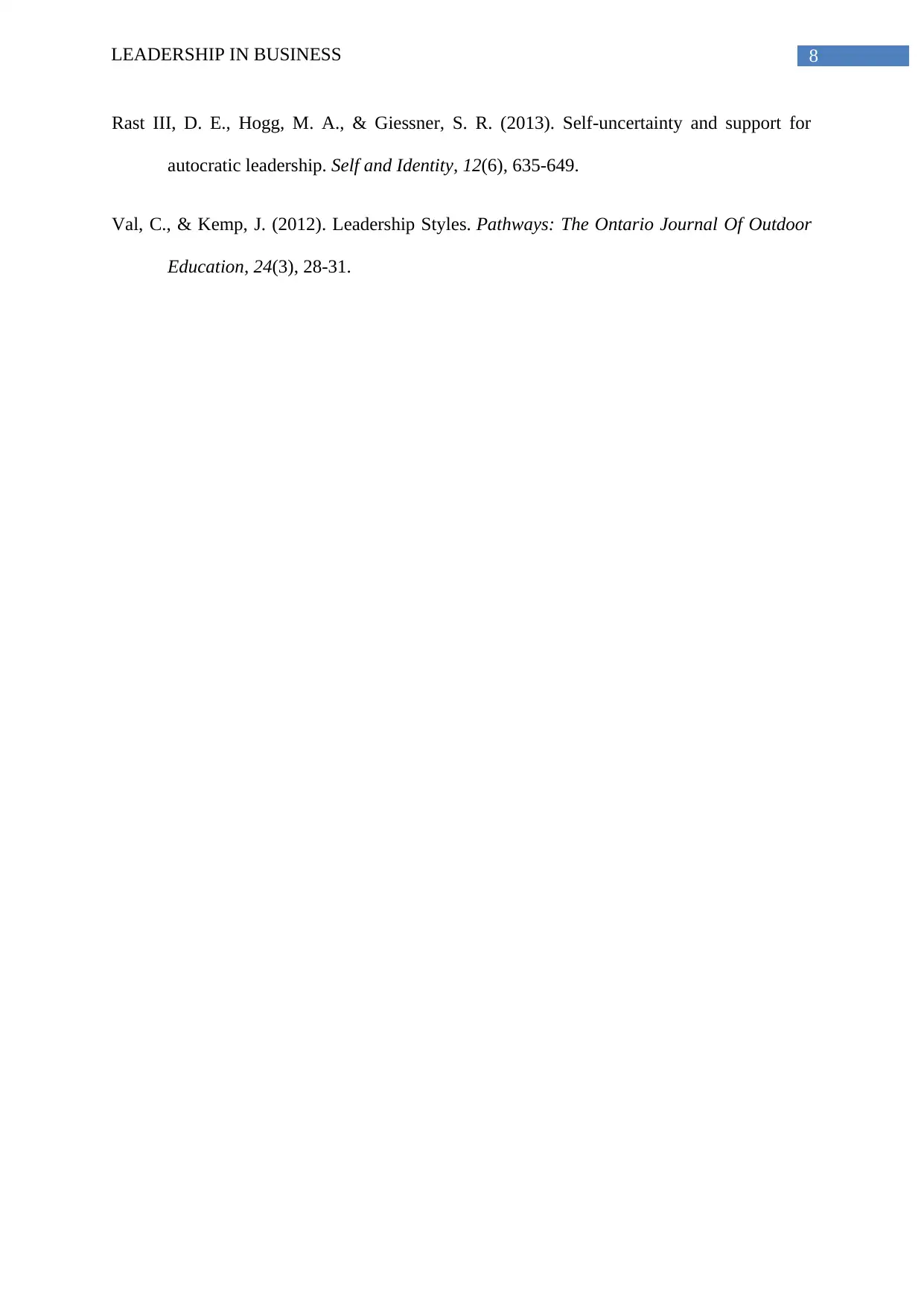
8LEADERSHIP IN BUSINESS
Rast III, D. E., Hogg, M. A., & Giessner, S. R. (2013). Self-uncertainty and support for
autocratic leadership. Self and Identity, 12(6), 635-649.
Val, C., & Kemp, J. (2012). Leadership Styles. Pathways: The Ontario Journal Of Outdoor
Education, 24(3), 28-31.
Rast III, D. E., Hogg, M. A., & Giessner, S. R. (2013). Self-uncertainty and support for
autocratic leadership. Self and Identity, 12(6), 635-649.
Val, C., & Kemp, J. (2012). Leadership Styles. Pathways: The Ontario Journal Of Outdoor
Education, 24(3), 28-31.
⊘ This is a preview!⊘
Do you want full access?
Subscribe today to unlock all pages.

Trusted by 1+ million students worldwide
1 out of 9
Related Documents
Your All-in-One AI-Powered Toolkit for Academic Success.
+13062052269
info@desklib.com
Available 24*7 on WhatsApp / Email
![[object Object]](/_next/static/media/star-bottom.7253800d.svg)
Unlock your academic potential
Copyright © 2020–2025 A2Z Services. All Rights Reserved. Developed and managed by ZUCOL.





